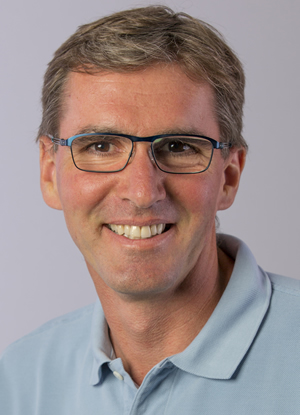NIF Physicist Among Four LLNL Scientists Honored as APS Fellows
October 21, 2020
Physicist Laurent Divol of the NIF and Photon Science Directorate was one of four Lawrence Livermore National Laboratory (LLNL) scientists selected as 2020 fellows of the American Physical Society (APS).
Divol, who is with NIF’s High Energy Density (HED) science program, was selected “for fundamental contributions to laser plasma physics in hohlraums and other HED experiments, and for leadership in the design of high-yield deuterium-tritium (DT) experiments.”
“I am honored to have been elected an APS fellow of the Plasma Physics Division,” he said.
 Laurent Divol.
Laurent Divol. APS fellowships are awarded after extensive review and are considered a distinct honor because the evaluation process - conducted by the fellowship committees of individual divisions, topical groups, and forums - relies on nominations and recommendations by professional peers.
Divol joined the Lab in 2001 and works on many subjects related to inertial confinement fusion (ICF), most involving lasers and plasmas. He arrived as the NOVA laser closed and NIF’s construction began. He was named to the Lab’s Early and Mid-Career Recognition Program in 2018.
“I have enjoyed 10 years of preliminary studies and design followed by 10 years of direct applications on NIF,” Divol said. “I feel this fellowship is a recognition of my contributions to many ICF projects I had the opportunity of joining or leading over this time, an opportunity really unique to national labs.”
In the future, Divol said he will continue striving with the team trying to achieve ignition at NIF.
The new fellows represent a selection of physics expertise, including laser plasma physics, magnetic fusion plasmas, the theoretical and computational understanding of plasma interactions, and soft x-ray and free-electron laser platforms.
The APS also selected:
Max Fenstermacher
Max Fenstermacher, a plasma physicist in the Physics Division of the Physical and Life Sciences Directorate (PLS), was cited “for using experiments and modeling to make important contributions to the understanding of tokamak divertor detachment, and to the characterization and control of edge-localized modes (ELMs) with resonant magnetic perturbations (RMPs) in magnetic fusion plasmas.”
“I'm very grateful to have worked with great collaborating team members who were key to the new physics understanding obtained especially from the work cited in this award,” he said.
Fenstermacher began his career in 1983 on location at LLNL as a member of the TRW plasma physics group and became a member of the LLNL staff in 1988. Since 1994, he has been located off-site as a member of the LLNL experimental team at the DIII-D National Fusion Facility in San Diego.
His expertise is in the physics of plasmas in magnetic confinement devices for fusion energy applications. He is working on the physics of controlling non-linear ELM instabilities in tokamaks using small 3D magnetic perturbation fields. He’s also the coordinator of the experimental program on the DIII-D National Fusion Facility in San Diego. In 2018, he was awarded the APS John Dawson Award for Excellence in Plasma Physics Research.
Next year, Fenstermacher will present the overview of the DIII-D experimental program at the IAEA Fusion Energy Conference on behalf of the DIII-D team. He also will become more involved in the ITER project as chair of the Pedestal and Edge Physics International Tokamak Physics Activity (ITPA) advisory group. ITER is an international nuclear fusion research and engineering megaproject that will be the world's largest magnetic confinement plasma physics experiment.
Richard Berger
Richard Berger, a theoretical plasma physicist who works in the Design Physics Division of the Weapons and Complex Integration Directorate, was selected “for pioneering vision for the crucial theoretical and computational understanding of plasma interactions with intense light and with other high energy density plasmas.”
“I am grateful to my colleagues who nominated me and pleased to receive this recognition from the American Physical Society,” Berger said.
He started at the Laboratory in 1991 and his research focuses on fluid and kinetic simulation of laser-plasma interactions. Other interests include multi-fluid hydrodynamics and kinetic instabilities driven by interpenetrating plasma flows.
He said that he is always interested “in learning and applying my skills to interesting problems.”
Art Nelson
Art Nelson, a senior research scientist in the PLS Materials Science Division, was cited for “outstanding contributions to the development of soft x ray and free electron laser analytical platforms and pump-probe techniques applied to understanding ultrafast surface phenomena and extreme states of matter.”
“I am truly honored to be elected as an APS fellow,” Nelson said. “I thank my many PLS collaborators and colleagues in the Peak Brightness Collaboration for supporting my nomination.”
He has worked at the Laboratory for 22 years. He originally joined the Lab in August 1997 as a postdoc, then took an eight-month leave to complete his Fulbright Scholar assignment at the Elettra Sincrotrone Trieste in Italy. He returned to the Lab in June 1998.
His area of expertise is condensed-matter physics, studying surface catalytic reactions using various Lab-based and synchrotron-based surface analysis techniques.
Nelson’s future endeavors will include mentoring postdoctoral and graduate students.
—Anne Stark
Follow us on Twitter: @lasers_llnl



